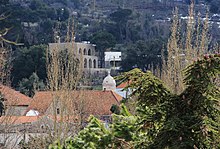Lebanese Maronite Christians
"[dubious – discuss][3] The 1860 Druze–Maronite conflict led to the establishment of Mount Lebanon Mutasarrifate, an autonomous entity within the Ottoman Empire dominated by Maronites and protected by European powers.The Maronite Christianity derived its name and religious identity from Saint Maron whose followers migrated to the area of Mount Lebanon (present day Republic of Lebanon) from their previous location of residence around the area of Antioch (an ancient Greek city within present day Hatay Province, Turkey), establishing the nucleus of the Maronite Church.[8] More specifically, Maron, a fourth-century monk and the contemporary and friend of St. John Chrysostom, left Antioch for the Orontes River to lead an ascetic life, following the traditions of Anthony the Great of the Desert and Pachomius.[9] The martyrdom of the Patriarch of Antioch in the first decade of the seventh century, either at the hands of Persian soldiers or local Jews,[10] left the Maronites without a leader, a situation which continued because of the final and most devastating Byzantine–Sassanid War of 602–628.In the aftermath of the war, the Emperor Heraclius propagated a new Christological doctrine in an attempt to unify the various Christian churches of the east, who were divided over accepting the Council of Chalcedon.Pope Honorius I (625–638) of Rome naively called for an end to dispute and interpreted Sergius' view as true since Christ exhibited only one will insofar as His sinless human will never disagreed with His divine will.This situation was mirrored in other Christian communities in the Byzantine Empire and helped facilitate the Muslim conquest of most of Eastern Christendom by the end of the century.The relationship between the Druze and Christians has been characterized by harmony and peaceful coexistence,[13][14][15][16] with amicable relations between the two groups prevailing throughout history, with the exception of some periods, including 1860 Mount Lebanon civil war.


Lebanese ArabicLebanese AramaicClassical SyriacChristianityMaronite CatholicLebanese peopleEmblemLebanonLebanese cedarreligionLebanese MuslimsLebanese ChristiansGreek OrthodoxMelkiteProtestantCyprusLebanese diasporaGermanyFranceUnited KingdomSwedenGreeceUnited StatesCanadaAustraliaNew ZealandArgentinaBrazilMexicoColombiaUruguayEcuadorVenezuelaJamaicaParaguayIvory CoastSenegalSierra LeoneSouth AfricaKuwaitUnited Arab EmiratesSaudi ArabiaLebanese cultureCultural Heritage sitesArchitectureLiteratureCinemaCuisineHistory of ancient LebanonHistory of LebanonTimeline of Lebanese historyPhoeniciaCounty of TripoliOttoman rule1860 conflictMount Lebanon Mutasarrifate1958 Lebanon crisisGreater LebanonLebanese Civil WarSouth Lebanon conflictTaif AgreementArabicFrenchFrench language in LebanonEnglishLebanese politicsPresidentPrime MinisterList of political parties in LebanonNational PactLebanese nationalismPhoenicianismCoat of arms of LebanonFlag of LebanonMaronite ChurchChristian bodyMount LebanonBeirutMaronitesMaronite–Druze dualism1860 Druze–Maronite conflictOttoman EmpireFirst World WarFrench MandateSecond World War1975–1990 civil warTaif AccordsShiitesSunnispresident of the countrySaint CharbelBachir GemayelShuf MountainsMaronites and the DruzeNational Geographic SocietyGenographic ProjectPierre ZallouaPhoenicianAntiochJesus Christdestruction of JerusalemSaint PeterApostolic FatherIgnatius of AntiochPatriarchatesPentarchyConstantineRepublic of LebanonHatay ProvinceSt. John ChrysostomOrontes RiverasceticAnthony the GreatPachomiusCouncil of ChalcedonMonophysitesPope HormisdasByzantine–Sassanid War of 602–628HeracliusmonothelitismJacobitesMonoenergismPatriarchSergius I of ConstantinoplePope Honorius ISixth Ecumenical Council